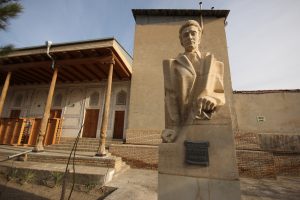In Bukhara, not far from the ancient Silk Road city’s famous center, there is a museum marked with a golden sign. In Uzbek, Russian, and English the sign declares the site the “House Museum of The Rich Merchant of Bukhara.”
Everyone knows exactly whose house it was.
Through the gate, and past the trees, there’s a statue of the rich merchant’s infamous son: Fayzulla Khodjaev (1896-1938).
Khodjaev lived at a critical nexus in history. Born into the family of a wealthy merchant in Bukhara just two years before the Russian Empire forced protectorate status on the emirate, Khodjaev was sent to Moscow for a secular education in 1907. When he returned to Bukhara in 1913, he brought with him the ideology of Pan-Turkism bubbling out of the Ottoman Empire and had joined the jadids, Muslim modernists set on reviving Islam in the Russian Empire via education and European-style reform. His return — and his family’s funds — injected new life into an underground movement modeled on the Young Turks, the Young Bukharans. The Young Bukharans opposed the emir and the conservative Islamic clergy that surrounded him, which acted against jadid efforts to introduce new styles of schooling in Bukhara.
In 1917, as revolution began to upturn the Russian Empire, Khodjaev and the Young Bukharans enticed the Bolsheviks in Tashkent to overthrow the emir in Bukhara. That first attempt failed and Khodjaev fled to Tashkent. In 1920, however, Khodjaev returned with the Red Army, led by Mikhail Frunze. The Young Bukharans made a deal with the communists to overthrow the emir and many, though not all, joined the Communist Party afterward.
Bukhara was bombed during the invasion, much of it turned to rubble. The Ark, the emir’s fortress that dated to the 5th century, fell to the Red Army. Independent Bukhara ended as the emir, Alim Khan, fled to Afghanistan.
Khodjaev served as head of the short-lived Bukharan People’s Soviet Republic that followed the end of the emirate. After the Soviet reorganization in 1924, in which the Uzbek Soviet Socialist Republic was formed and into which Bukhara was subsumed, Khodjaev continued to hold high positions, including as a representative of the chairman of Central Executive Committee of Uzbekistan at the USSR Central Executive Committee in Moscow.
But in 1937 he was declared an enemy of the people and dismissed. Like many among the Central Asian intelligentsia, he was a victim of Stalin’s great purge.
Although Khodjaev was officially rehabilitated in 1966, that his family’s house does not — on the sign outside — bear his name is a reflection of the controversy surrounding him. From one view, Khodjaev can easily be cast as a villain who sold out independent Bukhara to the communists. But from another view, Khodjaev was an aspiring agent of change overtaken by the greater forces moving history at the time.
And this history is not so distant from the present.
When I visited the Khodjaev house in December 2019, I was accompanied by Fayzulla’s grandson, noted Uzbek historian Suleyman Inoyatov, and the son of Fayzulla’s cousin Usmon, the U.S.-based, Turkish born, Uzbek scholar Timur Kocaoglu. Just a few streets away from the Khodjaev house is Usmon’s home, the site of one of Bukhara’s first jadid schools — opened in 1914.
Unlike Fayzulla, Usmon never settled into communism. He left Bukhara in 1922, never to return. While in neighboring Afghanistan, he was warned by his cousin that the Russians would kill him if he came back. Having left his first wife and son in Bukhara, he eventually settled in Turkey and there started a second life, publishing anti-Soviet, Pan-Turkist pamphlets. His house in Bukhara fell into Soviet hands around the same time his cousin was executed as an enemy of the people in Moscow. Having already been a home and a school, it then became a Soviet prosecutor’s office and a jail. The house eventually passed back into private hands.
Timur wanted to stay a night at his father’s house in Bukhara. At present, the current owner is in the process of renovating the house, which dates to 1865, in order to operate it as a hotel. For $25 each we were the hotel’s only guests, winter being an off-season for tourists even in the heart of Bukhara’s old streets.
The author wishes to thank Timur Kocaoglu, Suleyman Inoyatov, and their friends for their kindness and for showing her the wonders of Bukhara.
















































